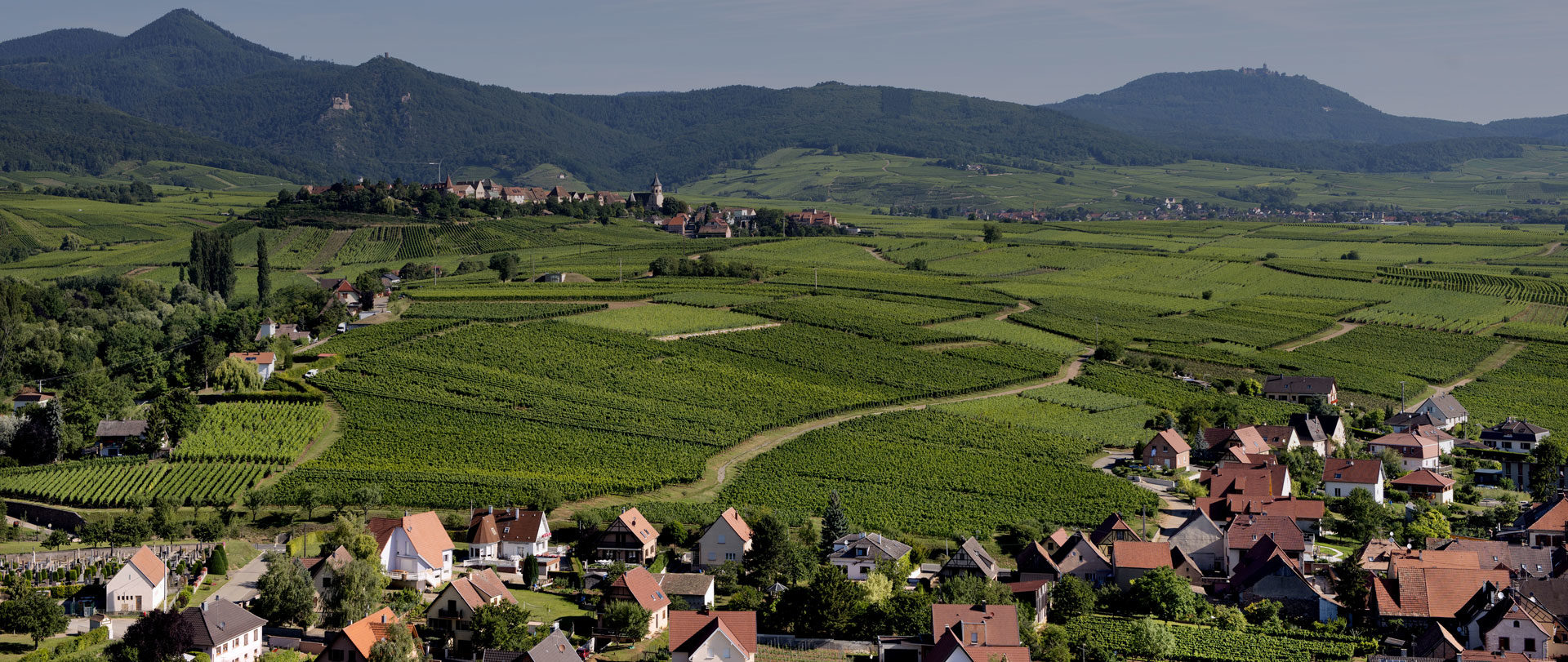The terroir
Its name, ‘Sonnenglanz’, literally ‘sunshine’ in Alsatian, alone expresses the richness of this terroir. Here, the sun slowly polishes the grapes. The quality and rhythm of their ripening owe everything to the combination of the resources of the soil and the gifts of light.
Located in the commune of Beblenheim, Sonnenglanz is part of the Ribeauvillé fault zone. Its vines face south-east, at an altitude of between 220 and 270 metres, on a gentle slope of between 10 and 25%.
History
The quest for quality is part of the ancestral winegrowing heritage of the Beblenheim winegrowers. As early as the 16th century, vine-growing was regulated here. The Sonnenglanz was also one of the first terroirs to benefit from a legally recognised demarcation, at the request of the producers.
Vines have been grown in Beblenheim since the Middle Ages. The Benedictine abbey of Marmoutier and the Cistercian abbey of Pairis in the Vosges both had vineyards here.
Beblenheim’s winegrowers have always been accustomed to producing quality wines,’ explains Marcel Kraemer, a former school headmaster and custodian of the village’s collective memory. As far back as the 16th century, regulations specified the types of plants to be grown. The gardes-champêtres were responsible for monitoring and uprooting non-compliant plants. Repeat offenders were fined heavily.
The small municipality has remained faithful to this spirit of rigour imposed for more than four centuries by its former masters, the Dukes of Württemberg.
In 1935, at the request of the Beblenheim winegrowers’ association, the Colmar district court convicted a winegrower of selling wine under the name Sonnenglanz when it came from another locality. The court’s decision also delimited the production area and laid down the conditions for grape varieties, thereby recognising the specific characteristics of this terroir, almost 50 years before it became part of the Alsace Grand Cru appellation in 1983!
Christian Oberlin was also born here. His work and experiments with grafting American vines saved the Alsace vineyards from destruction by phylloxera.
The wines
Sonnenglanz reveals the sunny spirit of this terroir
« The palate is full-bodied and rich, revealing the high level of maturity achieved here. This is expressed by exotic notes of pineapple, mango and passion fruit.
The different grape varieties each bring their own aromatic touches, but nevertheless retain the characteristics of ripeness, with notes of over-ripe or candied fruit. The wines retain their balance thanks to their fresh acidity, which is very noticeable on the mid-palate. »
Pairings
« These wines are open and fruity, with a tender structure, so they quickly give pleasure. However, five to six years’ cellaring will refine their substance and make them more complex.
In early vintages, the very ripe fruit and honey are bewitching, and the structure of the wines is generous. Their aromatic intensity makes them wines of character and charm, with a perfectly integrated gourmet sweetness.
In late vintages, the fruit is still there, combined with a more airy, tauter but dense body. »
Major pairings
“The freshness and balance of Sonnenglanz wines open the door to a wide range of gastronomic daring. Their breadth and generosity allow Oriental or Indian cuisine to express itself fully. The notes of spices, saffron, coriander and cloves, which are often the signature of these cuisines, combine perfectly with the natural volume of the wines.
This Grand Cru also goes well with exotic fruit desserts.“
Photo © ZVARDON / Textes CIVA – www.VinsAlsace.com





